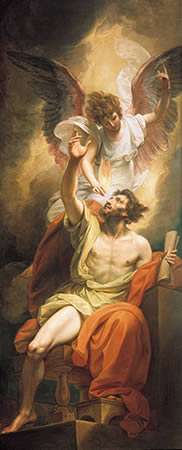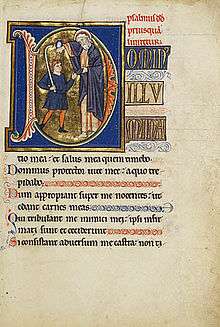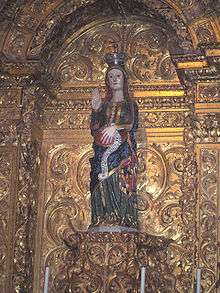O Antiphons

The O Antiphons, also known as The great Os are Magnificat antiphons used at Vespers of the last seven days of Advent in Western Christian traditions. They are also used as the alleluia verses on the same days in the Catholic Mass.
They are referred to as the "O Antiphons" because the title of each one begins with the interjection "O".[1] Each antiphon is a name of Christ, one of his attributes mentioned in Scripture. They are:
- December 17: O Sapientia (O Wisdom)
- December 18: O Adonai (O Lord)
- December 19: O Radix Jesse (O Root of Jesse)
- December 20: O Clavis David (O Key of David)
- December 21: O Oriens (O Dayspring)
- December 22: O Rex Gentium (O King of the nations)
- December 23: O Emmanuel (O With Us is God)
In the Roman Catholic tradition, the O Antiphons are sung or recited at Vespers from December 17 to December 23 inclusive. Some Anglican churches (e.g. the Church of England) also use them, either in the same way as modern Roman Catholics, or according to a medieval English usage (see below).
Use of the O Antiphons also occurs in many Lutheran churches. In the Book of Common Worship published by the Presbyterian Church (USA), the antiphons can be read as a praise litany at Morning or Evening Prayer. The hymn O come, O come, Emmanuel (in Latin, Veni Emmanuel) is a lyrical paraphrase of these antiphons.[2]
Origin

According to Fr. William P. Saunders,[3] "The exact origin of the O Antiphons is not known. Boethius (480–524) made a slight reference to them, thereby suggesting their presence at that time [the sixth century]. At the [Benedictine] [Fleury Abbey], these antiphons were recited by the abbot and other abbey leaders in descending rank, and then a gift was given to each member of the community. By the eighth century, they are in use in the liturgical celebrations in Rome. The usage of the O Antiphons was so prevalent in monasteries that the phrases, Keep your O and The Great O Antiphons were common parlance. One may thereby conclude that in some fashion the O Antiphons have been part of our liturgical tradition since the very early Church."[4]
Acrostic "Ero Cras"
The first letters of the titles taken backwards appear to form a Latin acrostic which translates to "Tomorrow, I will be [there]", mirroring the theme of the antiphons. Father Saunders wrote, "According to Professor Robert Greenberg of the San Francisco Conservatory of Music, the Benedictine monks arranged these antiphons with a definite purpose. If one starts with the last title and takes the first letter of each one - Emmanuel, Rex, Oriens, Clavis, Radix, Adonai, Sapientia - the Latin words ero cras are formed, meaning, Tomorrow, I will come. Therefore, the Lord Jesus, whose coming we have prepared for in Advent and whom we have addressed in these seven Messianic titles, now speaks to us, Tomorrow, I will come. So the O Antiphons not only bring intensity to our Advent preparation, but bring it to a joyful conclusion."[4]
However, Martin Connell,[5] a professor of theology, argues that the antiphons were not deliberately arranged this way. "[T]here is little or no support in the sources that this is anything more than a coincidence. Such a cryptic medium is not a common quality of liturgical practice and theology. Moreover, the number of O Antiphons varied from church to church and religious community to community, and those without ERO CRAS did not fashion their antiphons to construct a cryptic message....[i]n the whole of the liturgical tradition there has been no tradition of such a labyrinthine way of mediating what God communicates to humanity in his Son....The encrypted message that he will 'come tomorrow' is not characteristic of how the church brings its worship traditions to light."[6]
A number of other antiphons were found in various medieval breviaries.[7]
Analysis
The importance of the "O Antiphons" is twofold. First, each one is a title for the Messiah. Secondly, each one refers to the prophecy of Isaiah of the coming of the Messiah. The Latin antiphons are from the Breviarium Romanum. The English versions, which are not always literal translations of the Latin, are from the Church of England's Common Worship liturgy. Biblical quotations are from the NRSV.
O Sapientia

Latin:
- O Sapientia, quae ex ore Altissimi prodiisti,
- attingens a fine usque ad finem,
- fortiter suaviterque disponens omnia:
- veni ad docendum nos viam prudentiae.[8]
English:
- O Wisdom, coming forth from the mouth of the Most High,
- reaching from one end to the other,
- mightily and sweetly ordering all things:
- Come and teach us the way of prudence.
Isaiah had prophesied:
- "The spirit of the Lord shall rest on him, the spirit of wisdom and understanding, the spirit of counsel and might, the spirit of knowledge and the fear of the Lord. His delight shall be in the fear of the Lord." Isaiah 11:2-3
- "[...] he is wonderful in counsel, and excellent in wisdom." Isaiah 28:29
Also compare Sirach 24:1-5 and Wisdom of Solomon 8:1
This prophecy is also relevant in that it describes the Messiah as "coming forth from the mouth of the Most High", which is very significant in light of the Christian doctrine, rooted in the first chapter of the Gospel of John, according to which Jesus Christ, the Messiah, is the Incarnate Word of God the Father.
O Adonai

Latin:
- O Adonai, et Dux domus Israel,
- qui Moysi in igne flammae rubi apparuisti,
- et ei in Sina legem dedisti:
- veni ad redimendum nos in brachio extento.
English:
- O Adonai, and leader of the House of Israel,
- who appeared to Moses in the fire of the burning bush
- and gave him the law on Sinai:
- Come and redeem us with an outstretched arm.
Isaiah had prophesied:
- "[...] but with righteousness he shall judge the poor, and decide with equity for the meek of the earth; he shall strike the earth with the rod of his mouth, and with the breath of his lips he shall kill the wicked. Righteousness shall be the belt around his waist, and faithfulness the belt around his loins." Isaiah 11:4-5
- "For the Lord is our judge, the Lord is our ruler, the Lord is our king; he will save us." Isaiah 33:22
Also compare Exodus 3:2 and Exodus 24:12
O Radix Jesse

Latin:
- O Radix Jesse, qui stas in signum populorum,
- super quem continebunt reges os suum,
- quem Gentes deprecabuntur:
- veni ad liberandum nos, jam noli tardare.
English:
- O Root of Jesse, standing as a sign among the peoples;
- before you kings will shut their mouths,
- to you the nations will make their prayer:
- Come and deliver us, and delay no longer.
Isaiah had prophesied:
- "A shoot shall come out from the stock of Jesse, and a branch shall grow out of his roots." Isaiah 11:1
- "On that day the root of Jesse shall stand as a signal to the peoples; the nations shall inquire of him, and his dwelling shall be glorious." Isaiah 11:10
Jesse was the father of King David, and Micah had prophesied that the Messiah would be of the house and lineage of David and be born in David’s city, Bethlehem (Micah 5:2). Also compare Isaiah 45:14, Isaiah 52:15 and Romans 15:12.
O Clavis David

Latin:
- O Clavis David, et sceptrum domus Israel;
- qui aperis, et nemo claudit;
- claudis, et nemo aperit:
- veni, et educ vinctum de domo carceris,
- sedentem in tenebris, et umbra mortis.
English:
- O Key of David and sceptre of the House of Israel;
- you open and no one can shut;
- you shut and no one can open:
- Come and lead the prisoners from the prison house,
- those who dwell in darkness and the shadow of death.
Isaiah had prophesied:
- "I will place on his shoulder the key of the house of David; he shall open, and no one shall shut; he shall shut, and no one shall open." Isaiah 22:22
- "His authority shall grow continually, and there shall be endless peace for the throne of David and his kingdom. He will establish and uphold it with justice and with righteousness from this time onwards and for evermore." Isaiah 9:7
- "...To open the blind eyes, to bring out the prisoners from the prison, and them that sit in darkness out of the prison house."Isaiah 42:7.
O Oriens

Latin:
- O Oriens,
- splendor lucis aeternae, et sol justitiae:
- veni, et illumina sedentes in tenebris, et umbra mortis.
English:
- O Morning Star,
- splendour of light eternal and sun of righteousness:
- Come and enlighten those who dwell in darkness and the shadow of death.
(Note: A literal translation of the Latin yields "O Rising Sun", but the poetic "O Morning Star" or "O Dayspring" is often preferred.)
Isaiah had prophesied:
- "The people who walked in darkness have seen a great light; those who lived in a land of deep darkness—on them light has shined." Isaiah 9:2
Also compare Isaiah 60:1-2 and Malachi 4:2 or Malachi 3:20 (Hebrew text)[9]
O Rex Gentium

Latin:
- O Rex Gentium, et desideratus earum,
- lapisque angularis, qui facis utraque unum:
- veni, et salva hominem,
- quem de limo formasti.
English:
- O King of the nations, and their desire,
- the cornerstone making both one:
- Come and save the human race,
- which you fashioned from clay.
Isaiah had prophesied:
- "For a child has been born for us, a son given us; authority rests upon his shoulders; and he is named Wonderful Counsellor, Mighty God, Everlasting Father, Prince of Peace." Isaiah 9:6
- "He shall judge between the nations, and shall arbitrate for many peoples; they shall beat their swords into ploughshares, and their spears into pruning-hooks; nation shall not lift up sword against nation, neither shall they learn war anymore." Isaiah 2:4
Also compare Isaiah 28:16 and Ephesians 2:14
O Emmanuel

Latin:
- O Emmanuel, Rex et legifer noster,
- exspectatio Gentium, et Salvator earum:
- veni ad salvandum nos, Domine, Deus noster.
English:
- O Emmanuel, our king and our lawgiver,
- the hope of the nations and their Saviour:
- Come and save us, O Lord our God.
Isaiah had prophesied:
- "Therefore the Lord himself will give you a sign. Look, the young woman is with child and shall bear a son, and shall name him Immanuel." Isaiah 7:14
(Emmanuel means God is with us).
Alternative English usage
Although the antiphons and dates shown above have been fairly universally recognised throughout western Christendom, an alternative English medieval practice arose of moving all of the antiphons forward by one day (commencing therefore on 16 December) and adding another (eighth) antiphon on 23 December, with the acrostic thus becoming Vero cras, "truly, tomorrow". This is the antiphon O Virgo virginum (O Virgin of virgins), with the following text:
Latin:
- O Virgo virginum, quomodo fiet istud?
- Quia nec primam similem visa es nec habere sequentem.
- Filiae Jerusalem, quid me admiramini?
- Divinum est mysterium hoc quod cernitis.
English:
- O Virgin of virgins, how shall this be?
- For neither before thee was any like thee, nor shall there be after.
- Daughters of Jerusalem, why marvel ye at me?
- The thing which ye behold is a divine mystery.
Given the English origins of this alternative, it has traditionally been the version used in the Church of England (including Canterbury Cathedral) until modern times, and is the version printed in traditional Church of England liturgical sources including the English Hymnal and New English Hymnal. From 2000, however, the Church of England appears to have taken an official step away from English medieval practice towards the more universal norm, as Common Worship makes provision for the sevenfold version of the antiphons, and not the eightfold version.[10]
This additional antiphon also appears in the Graduale of the Premonstratensian Order and it is still used by those monasteries.
Antiphons on the Benedictus

Two more antiphons which also relate to the theme of the upcoming birth of Christ accompany the O Antiphons at Lauds on December 21 and 23. The first, due to the Feast of St. Thomas falling on December 21, is traditionally used instead in the commemoration of the feria. With the transference of the Feast of St. Thomas to July 3 in the revised calendar, these are again used in the Liturgy of the Hours as antiphons. The Monday through Saturday which fall on the days of the O Antiphons also have their own antiphons for the psalms of Lauds, rather than the usual weekday antiphons.
December 21
Nolite timere: quinta enim die veniet ad vos Dominus noster.
- Fear not, for on the fifth day our Lord will come to you.
December 23
Ecce completa sunt omnia, quae dicta sunt per Angelum de Virgine Maria.
- Behold, all things are fulfilled, which were spoken by the Angel to the Virgin Mary.
Musical settings
Marc-Antoine Charpentier completed a setting of the O Antiphons in the early 1690s. The English Hymnal contains a plainsong setting in English by Ralph Vaughan Williams. In the twentieth century, the Estonian composer Arvo Pärt set a German translation of these antiphons for SATB unaccompanied choir, under the title Magnificat Antiphonen. The British composer Bob Chilcott has set the Latin version of these antiphons for SSAATTBB unaccompanied choir, under the title Advent Antiphons. Others include a major setting (35 minutes) in Latin by Polish composer Paweł Łukaszewski, composed between 1995–99; settings by American composers John Muehleisen (1996) and R. Anthony Lee (1999); and by the well-known American composer of liturgical music in the Episcopalian and Anglican traditions, Peter Hallock, whose two settings were composed in 1986 and 1989. The choral setting of the antiphons by Anglo-Canadian composer Healey Willan continues in use throughout the Anglican Communion. Another Canadian setting was written by Robert Grandy for SSAATTBB choir, soloists, organ and handbells.
See also
Media
 Antiphon "O Sapientia quae ex ore Altissimi..."
Antiphon "O Sapientia quae ex ore Altissimi..."  Antiphon O Adonai II Great Advent Antiphon
Antiphon O Adonai II Great Advent Antiphon - "BinAural Collaborative Hypertest". Retrieved 19 December 2013.
- "Sapientia". Archived from the original on July 6, 2008. Retrieved 28 November 2007.
- "Adonai". Retrieved 28 November 2007.
- "Radix Jesse". Retrieved 28 November 2007.
- "Oriens". Retrieved 28 November 2007.
- "Rex Gentium". Retrieved 28 November 2007.
References
- ↑ Bower, Peter C. (2003). The Companion to the Book of Common Worship. Geneva Press. p. 100. ISBN 978-0664502324.
- ↑ "O come, O come, Emmanuel". Dominican Friars of the Province of St. Joseph. Retrieved 19 April 2013.
- ↑ "Scholar's Archives: Saunders, Rev. William, Ph.D.," Institute of Catholic Culture. Retrieved December 14, 2015.
- 1 2 Saunders, William. What are the "O Antiphons"?, CatholicEducation.org, retrieved December 14, 2015.
- ↑ Martin Connell, Ph.D., Professor of Theology, Saint John’s University. Retrieved December 14, 2015.
- ↑ Connell, Martin. Eternity Today: On the Liturgical Year, Volume 1: On God and Time, Advent, Christmas, Epiphany, Candlemas. Continuum International Publishing Group, Inc., New York, 2006, p. 73. Retrieved December 14, 2015.
- ↑
 Herbermann, Charles, ed. (1913). "O Antiphons". Catholic Encyclopedia. New York: Robert Appleton Company.
Herbermann, Charles, ed. (1913). "O Antiphons". Catholic Encyclopedia. New York: Robert Appleton Company. - ↑ The Great antiphon for 17 December sung by the Dominican student brothers at Blackfriars in Oxford on YouTube
- ↑ Biblia Hebraica Stuttgartensia, p. 1085
- ↑ Common Worship: DailyPrayer, Church House Publishing, 2005, ISBN 978-0-7151-2073-6, page 211.
External links
| Wikimedia Commons has media related to O antiphons. |
| Wikisource has original text related to this article: |
- A reflection on the O Antiphons from Anglicans Online
- The Advent Antiphons, by A.C.A. Hall, 1914 commentary and paraphrase.
- Saunders, Fr. William, What are the O Antiphons?
- Stewart, Andrew
- Umilta Website on Julian of Norwich
